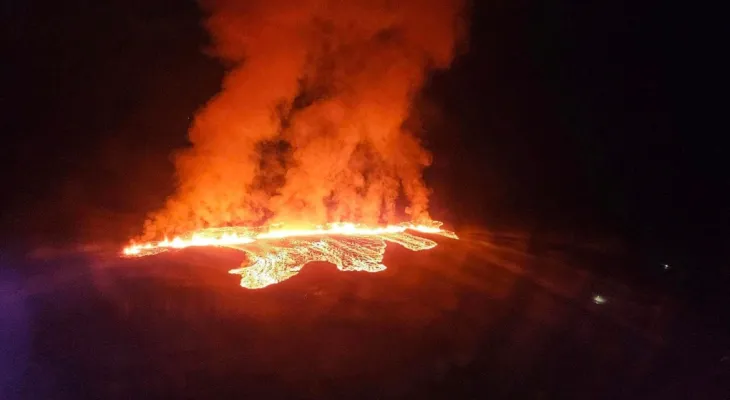Search here
Newspaper
Search here

Arab Canada News
News

Published: January 14, 2024
A volcano erupted in southwest Iceland for the second time in less than a month on Sunday, causing lava to flow towards a nearby community and setting fire to at least one house.
The Icelandic Meteorological Office said the eruption, which began before 8 a.m. local time, came after authorities evacuated the town of Grindavík following a series of small earthquakes. After hours, a second fissure opened near the edge of the town and lava seeped towards homes.
Reneir Berg Jonsson, a resident of Grindavík, told Icelandic television RUV: "We are just watching this through the cameras and there is nothing else we can do."
Grindavík is a town with a population of 3,800, located about 50 kilometers (30 miles) southwest of Reykjavik, Iceland’s capital. The community was previously evacuated in November after a series of earthquakes created large cracks in the ground between the town and the small Mount Sælingsfjall to the north. The nearby Blue Lagoon geothermal resort – one of Iceland’s largest tourist attractions – was also temporarily closed.
The volcano eventually erupted on December 18, and residents were allowed back into their homes on December 22.
The Meteorological Office said that in the weeks following, emergency workers built defensive walls around Grindavík, but the barriers were incomplete and the lava was moving towards the community.
Before last month’s volcanic eruption, the Svartsengi volcanic system north of Grindavík had been dormant for almost 780 years. The volcano is located a few kilometers west of Fagradalshraun, which had been dormant for 6,000 years before coming to life in March 2021.
Kristín Jónsdóttir from the Meteorological Office said that unlike the previous event, the Svartsengi volcano eruption on Saturday produced a "very fast" flow of lava moving south towards Grindavík.
She added: "Fortunately, we received some warnings, so there was increased earthquake activity, and civil protection was informed of all this, so the town of Grindavík was evacuated."
Iceland, which lies above a volcanic hot spot in the North Atlantic Ocean, experiences an average of one eruption every four to five years.
The 2010 eruption of the Eyjafjallajökull volcano was the most destructive in recent times, sending ash clouds into the atmosphere and disrupting air travel across the Atlantic for several months.
The Sunday eruption on the Reykjanes Peninsula is not expected to release large amounts of ash into the air. Guðjón Helgason, the press officer for the airport operator Isavia, said operations at Keflavík Airport are continuing as usual.
But Grindavík residents are closely watching the slowly unfolding disaster as billowing lava flows creep towards their homes.
Gerwin van Nieuwenhof, a nature photographer, said: "I really can't imagine what people are going through." "The fact that you can see this on TV, and the fact that you can see it on webcams, it’s a strange feeling to see a town almost being destroyed by slow motion at this stage."
Comments